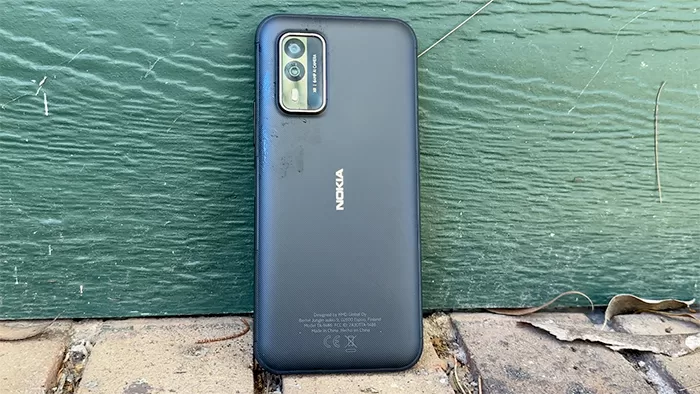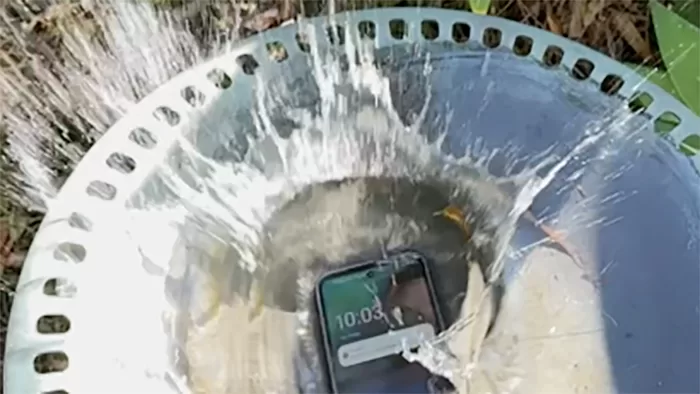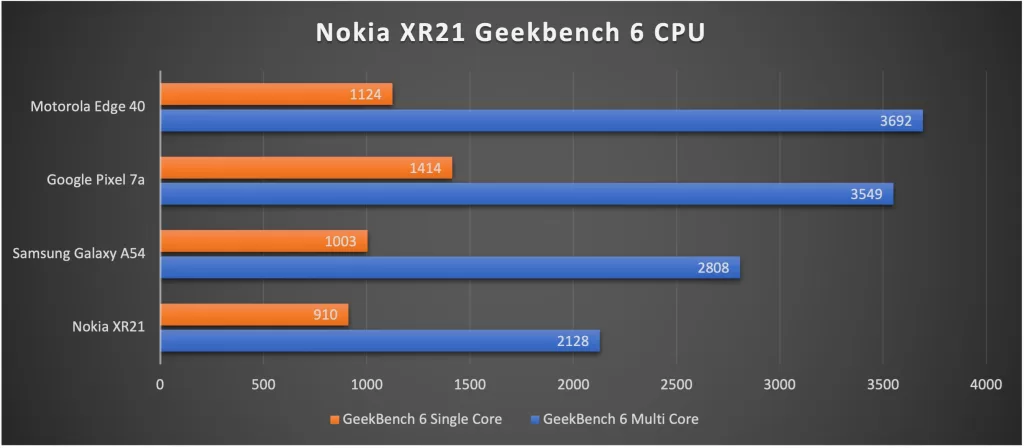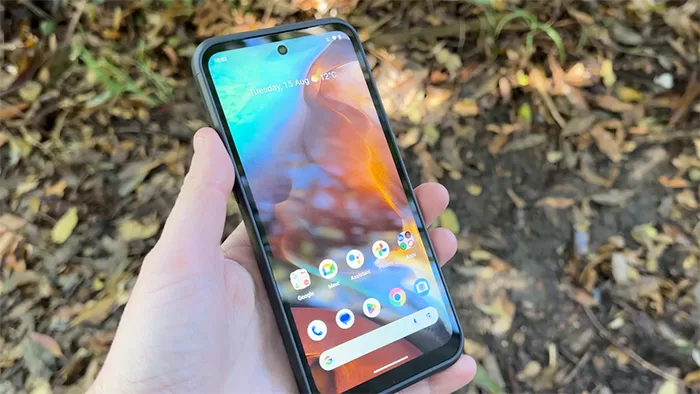
The Nokia XR21 fills a particular niche for users who want a phone that can take some thumps (and then some)
| Pros | Cons |
|---|---|
| It’s very rugged | Processor isn’t as powerful as others at this price |
| Multiple action buttons | Doesn’t live up to the 2-day battery life claim |
| 3 years of Android updates | Ordinary camera |
Score: 3.5/5
Broken phones are a fact of life, and it’s rare that I go a day or two without seeing somebody using a phone with a spiderweb-cracked screen or worse.
So why aren’t phones just made tougher, to resist all of life’s misfortunes? It’s to do largely with tradeoffs, because the more rugged you make a device, the heavier it gets and the more it costs to build. Over the years I’ve tested quite a few “rugged” phones, and they’ve generally done a good job of filling the niche of folks who need durability above all other factors, because there are always compromises made to meet price points with these devices.
That’s absolutely the case for the Nokia XR21. It’s the successor to the XR20, which I reviewed back when it was new, noting that “If you need moderate Android performance in a phone that can take a serious beating though, there’s nothing quite like it.”
Also Read:
Nokia XR20 Review (Finder)
Now there is, because the Nokia XR21 takes the promise of the XR20 and amps it up just a little bit, delivering better performance thanks to improved internals, as well as a very welcome upgrade schedule. Still, it’s a niche device for those situations where a regular smartphone won’t just bend, but outright break.
Design

The competition in the rugged smartphone space has never been massive; outside Nokia I can think of a few phones from Motorola, Samsung and some rebadged mostly-ZTE efforts out of Telstra that I’ve reviewed previously.
The Nokia XR21 follows the rugged playbook to the letter, and that letter is a chunky one. At 168×78.58×10.45mm and 231g, this is a big, heavy phone in your hand. Nokia – well, HMD Global, the company that has the licensing rights for “Nokia” phones – only makes the XR21 in two colour choices. You’ve either got the “Midnight Black” version I tested or a slightly more showy “Pine Green” variant to pick from.
At the front there’s a 6.49 inch 20:9 LCD display at 1080×2400 with support for up to 120Hz refresh rates. That’s slightly smaller than the XR20 was, but a little sharper as a result. At a maximum of 550 nits of brightness it’s not the shiniest of smartphone screens, and that could have an impact if you need a phone to work with outside in direct sunlight. It’s workable, but there are brighter phones for your money.
What there are not are tougher phones. This is the Nokia XR21’s real selling point, because it is IP69K rated for water and dust ingress. A fair number of phones offer water/dust resistance, typically maxing out at IP68, but IP69K is a whole new ballgame in terms of theoretical durability. As per the specification, this is a phone that should be entirely dust resistant while also being able to withstand high pressure and high temperature water sprays. It’s a standard typically used for the durability of food grade machinery, where you have to boil and blast away potential contaminants that could make people sick.
In theory, you could blast the Nokia XR21 with a high temperature, high pressure water hose and then eat your (very small) dinner off it safely.
No, I didn’t test that – mostly because I don’t have the right kind of hose, but also because HMD Global wanted their phone back. I did run it through some basic immersion tests and bump it down some stairs too to put its Corning Gorilla Glass Victus screen through its paces. HMD Global’s pretty convinced that the screen on the XR21 will last the distance, too, providing a one year single replacement warranty with it in Australia. So even if you did manage to break it, they’d repair it for nothing.
The Nokia XR21 has support for Bluetooth 5.1 – not exactly cutting edge – but also a 3.5mm headphone jack, which is an interesting inclusion on a rugged phone like this, as it must add complexity to its build process. On the more disappointing side, while it uses USB-C for charging, it’s with a USB 2.0 port only. If you need to use a cable to shift data off the Nokia XR21 for any reason, it’s going to be glacially slow.
I’ve tested a few phones recently that have chosen to include a secondary ‘action’ button. These were all the rage a few years back, mostly as fixed buttons to invoke Google Assistant or Samsung’s Bixby. The Nokia XR21 doesn’t just have one of these. It has two, one on the top and one on the side, and they can be configured for different actions as you like. It’s a nice inclusion, especially for a phone that might be working in hazardous environments where you might be wearing gloves and unable to interact directly with the touchscreen.
Camera

The Nokia XR21 comes with a 64MP primary wide and 8MP ultrawide camera, while at the front it features a 16MP selfie camera. While that’s a step up from the Nokia XR20 (48MP primary/13MP wide/8MP front), it’s still on the decidedly ordinary side for a phone that’s going to set you back $799 outright.
This is the price you pay for all that heavy duty rugged action, because it’s the priority here, not competing with the likes of the Google Pixel 7a or Motorola Edge 40. Predictably, this leaves the Nokia XR21 rather lagging behind what you can get elsewhere in mid-range cameras right now.
Also read:
Motorola Edge 40 Review
Google Pixel 7a Review
Basic camera performance is acceptable, because that’s a truism for any camera phone outside the very cheapest of the cheap. Beyond simple selfies and daylight shots, however, the quality does drop a touch, with night shots displaying significant grain and fast action harder to capture than I’d like from a $799 phone.
However, again, this is a phone that exists in service to its durability, and the camera phones at this price would likely melt if you hit them with a high pressure, high temperature hose…
Nokia XR21 Sample Photos




Performance

The Nokia XR21 runs on a Qualcomm Snapdragon 695 5G chip with 6GB of RAM and 128GB of fixed storage; that’s a somewhat older chip and a relatively mid-level recipe for a smartphone at this price point.
Again, it’s the sacrifice you make in return for that ultra-rugged style, because compared to the phones you can buy at this price point, the Nokia XR21 does not compare well in speed or graphics terms. Here’s how it compares against a range of similarly priced phones using Geekbench 6’s CPU benchmark:

The difference is even more stark looking at its 3DMark Wild Life Extreme scores:

As with any benchmark, comparisons can be useful but they don’t tell the whole story. As an everyday phone for basic tasks the Nokia XR21 is fine. HMD Global’s take on Android is relatively light on in terms of additional features and preinstalled apps and the like, which helps a fair amount. It’s also backed by the promise of 3 years of Android updates from its stock Android 13, which is great to see.
Battery

The Nokia XR21 is a big thick chunky phone, so it’s going to be packing a big thick chunky battery, right?
Not quite – or at least not quite by current Android standards. Its 4800mAh battery pack isn’t minute, but so many other Android phones, including those much cheaper than the XR21 can manage a 5,000mAh battery pack. It’s a guess, but once again I think the XR21 is making sacrifices for durability, and perhaps there’s no way to cram in the battery cells and keep them quite as protected.
Battery capacity is one thing; battery life is another, and HMD Global makes the bold claim that the XR21 is capable of up to two days of battery life. I’ve never met a phone I can’t send flat in just one day if I try hard enough, but to give the XR21a fair shot, I ran it through my standard YouTube streaming test, running a 1080p video at maximum brightness and moderate volume from a full battery.
What I look for here is at least 90% battery remaining after an hour; phones that score less than that will often struggle to last out a full day. So how does the Nokia XR21 compare?

Ah… well, that’s awkward, now isn’t it? To its credit, HMD Global is a lot more upfront about how it got that 2-day claim, stating that it came from a fresh phone using a mix of apps for 5 hours per day, with the phone on standby overnight. I can see how that’s maybe achievable at a stretch, but if you’re a very frequent phone user, you’ll need to take a charger with you.
To be more specific, you’ll need to buy a charger, because the Nokia XR21 only includes a USB-C cable in the box. There’s no capacity for Qi Wireless Charging support, either, though it will pull through up to 33W from a compatible plug.
Nokia XR21: Alex’s Verdict
There is exactly one reason to buy the Nokia XR21.
It’s tough.
Very tough, and may have already mentioned that before.
Everything on this phone exists in service to that toughness, so if you’re working in an environment which is hazardous to electronics, this is an easy recommendation. Likewise, if you have kids who are very careless with their gadgets, this would do the trick.
However, you do need to balance that against the fact that while it’s rugged, it’s also not fast, not particularly blessed with great battery life or spectacular cameras, and if those are important to you, you can do a lot better for this kind of money.
Nokia XR21: Pricing and availability
The Nokia XR21 retails in Australia for $799.
Buy On Amazon








